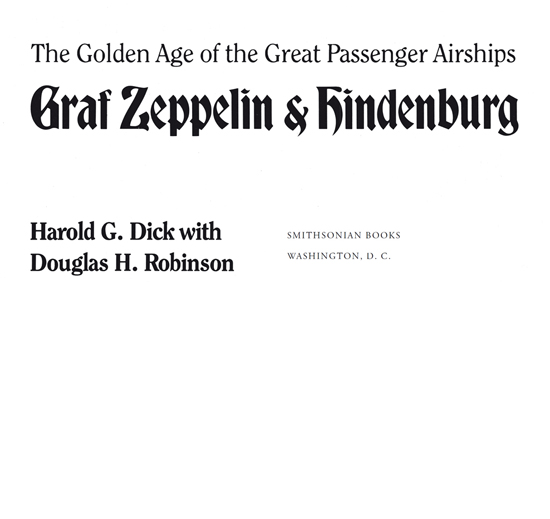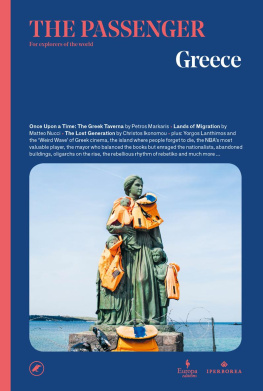Harold Dick - The Golden Age of the Great Passenger Airships
Here you can read online Harold Dick - The Golden Age of the Great Passenger Airships full text of the book (entire story) in english for free. Download pdf and epub, get meaning, cover and reviews about this ebook. year: 2014, publisher: Smithsonian, genre: Non-fiction. Description of the work, (preface) as well as reviews are available. Best literature library LitArk.com created for fans of good reading and offers a wide selection of genres:
Romance novel
Science fiction
Adventure
Detective
Science
History
Home and family
Prose
Art
Politics
Computer
Non-fiction
Religion
Business
Children
Humor
Choose a favorite category and find really read worthwhile books. Enjoy immersion in the world of imagination, feel the emotions of the characters or learn something new for yourself, make an fascinating discovery.

- Book:The Golden Age of the Great Passenger Airships
- Author:
- Publisher:Smithsonian
- Genre:
- Year:2014
- Rating:4 / 5
- Favourites:Add to favourites
- Your mark:
- 80
- 1
- 2
- 3
- 4
- 5
The Golden Age of the Great Passenger Airships: summary, description and annotation
We offer to read an annotation, description, summary or preface (depends on what the author of the book "The Golden Age of the Great Passenger Airships" wrote himself). If you haven't found the necessary information about the book — write in the comments, we will try to find it.
The Golden Age of the Great Passenger Airships — read online for free the complete book (whole text) full work
Below is the text of the book, divided by pages. System saving the place of the last page read, allows you to conveniently read the book "The Golden Age of the Great Passenger Airships" online for free, without having to search again every time where you left off. Put a bookmark, and you can go to the page where you finished reading at any time.
Font size:
Interval:
Bookmark:


Copyright 1985 by the Smithsonian Institution.
All rights are reserved.
This book was edited by Ruth W. Spiegel.
Library of Congress Cataloging-in-Publication Data:
Dick, Harold G.
The golden age of the great passenger airships,
Graf Zeppelin and Hindenburg.
Includes bibliographical references.
1. Graf Zeppelin (Airship)History. 2. Hindenburg (Airship)History. I. Robinson, Douglas Hill, 1918 . II. Title.
TL659.G7D53 1984 629.13325 84-600298
ISBN 978-1-56098-219-7
eBook ISBN: 978-1-58834-444-1
Photographs not otherwise credited are from Luftschiffbau Zeppelin, Friedrichshafen.
: Photograph by Harold G. Dick of the Hindenburg being brought out for the second takeoff on the March 26, 1936, propaganda flight after temporary repairs had been made for damage incurred on the first takeoff. The Graf Zeppelin is seen overhead (Fig. 56).
This book may be purchased for education, business, or sales promotional use. For information please write: Special Markets Department, Smithsonian Books, P.O Box 37012, MRC 513, Washington, DC 20013.
www.SmithsonianBooks.com
v3.1
This book is dedicated to the memory of Dr. Hugo Eckener and Paul W. Litchfield, men of vision, who in the early 1900s had the foresight to see the possibility and capability of the great rigid airship in transoceanic commerce and transportation.
As the era of the big rigid airship receded into the past it became very evident that a close experience with the engineering design, construction, and operation of the big airships warranted recording the salient features of that fascinating era of flight. The period involved covers the years 1934 through 1938 when the Graf Zeppelin was making regularly scheduled passenger-carrying flights from Germany across the South Atlantic to Rio de Janeiro and the Hindenburg was making the first regularly scheduled passenger-carrying flights across the North Atlantic as well as nonstop flights from Germany across the South Atlantic to Rio.
The successful operation of the two great airships was followed by the disastrous burning of the Hindenburg. There followed the conversion of the Hindenburgs sister ship to the use of helium instead of hydrogen with all the necessary arrangements for storing and purifying the helium. Then came the program for increasing the docking and operating facilities for a projected fleet of four great airships designed to carry passengers in luxury and comfort across the North Atlantic from Europe to the United States and return.
It was my good fortune as a young man to be involved in that fascinating period. I was uniquely qualified for my assignment to the Luftschiffbau Zeppelin by having an engineering degree from MIT, free balloon and blimp (nonrigid airship) licenses, and several years experience in the actual design and engineering of the big rigid airships Akron and Macon.
Recording much of the information followed natural channels by way of my reports from Germany to Goodyear-Zeppelin and progress reports to President Paul W. Litchfield. In the later years, 1937 and 1938, as Germany became more involved with Nazism and rearmament, reports and technical information could not be forwarded to Goodyear but information could still be collected and retained in my personal notes. Because of the close and friendly relationship with the Luftschiffbau Zeppelin personnel, there was never any question concerning my accumulation of data.
This collection of data concerning the design, engineering, construction, and operation of the big rigid airships is the basis of this presentation. Material includes extensive notes, reports, and recorded data, all of which had to be edited and reduced to workable quantities, a monumental task.
The best qualified person to do this was Dr. Douglas H. Robinson, author of several books on the big rigid airships, who is recognized as the foremost historian concerning the big rigids not only in this country but in England and Germany as well.
My first contact with Doug Robinson was in the summer of 1937 when Doug, then nineteen years old, was bicycle touring through Europe and had stopped at Friedrichshafen to see the sister ship to the Hindenburg, the LZ 130, later named the Graf Zeppelin II. A call from Knut Eckener took me to Knuts office where I met Doug and then took him through the hangar showing him the LZ 130 which was then being modified to operate with helium inflation. I remember particularly Dougs repeated requests to be taken up into the ship but this was impossibleverbotenfor safety reasons.
Years later our paths crossed again with Dr. Douglas H. Robinson taking on the chore of reducing the tremendous amount of information and data to workable proportions.
Much additional data and engineering information is available, too extensive and detailed to be included in this book. As it stands, I hope the story will interest even those who have never seen the giant rigid airships for it presents a participants recollections of the years he devoted to building and flying them.
The opinions expressed in this book are my own.
Harold G. Dick
I am very grateful to Dr. Hugo Eckener who kept me informed of new and special developments and who made it possible for me to participate in so many flights of the Hindenburg, particularly the first test flight when I was the only person aboard not on the Luftschiffbau payroll.
The cooperation and assistance given by the engineering personnel of the Luftschiffbau Zeppelin and the operating personnel of the Reederei must be recognized. Without their willingness to share information this story would not be complete.
Dr. Karl Arnstein must be recognized for his help and support. His desire to have an engineering representative on board the Graf Zeppelin and Hindenburg as well as in close contact with the engineering and construction personnel at Luftschiffbau Zeppelin was of invaluable assistance during my stay in Friedrichshafen.
Special appreciation is due to Knut Eckener who not only offered information on the fabrication and erection of the Hindenburg and Graf Zeppelin II but also helped to make my stay in Germany more interesting by opening his home to me, inviting me to attend the Oktoberfest in Munich, and introducing me to some of the fascinating spots in the Friedrichshafen area.
Last, but not least, I am also grateful to Dr. Ross Taylor, professor and head of the English Department and head of the Department of American Studies at Wichita State University, who for many years insisted that I record in the greatest detail not only the engineering aspects of my five years in Germany, but also my association with Dr. Eckener, his son Knut, and other personnel of the Luftschiffbau Zeppelin. Without Dr. Taylors insistence, this book would not have been written.
In the period before World War II, both authors had access to the photographic archives of the Luftschiffbau Zeppelin, and procured many copies for their own use. It was assumed that the original photographic collection had been destroyed in the heavy bombing of Friedrichshafen during the war. In fact, the archives had been packed and dispersed in villages around the town, but were subsequently seized by the French, who occupied the area after the German surrender, and were taken away to an unknown destination. In 1955, Dr. Robinson learned that the City of Friedrichshafen was planning a small museum on the top floor of the city hall, and he wrote to the Brgermeister, Dr. Grnbeck, inquiring about the photographs of the Zeppelin Company in view of his plans to use them in a published article. Dr. Grnbeck gave him permission to use any of the Luftschiffbau Zeppelin photos, but also requested that he send copies of the ones in his possession as the originals had disappeared. This was done. Subsequently a German official by accident discovered the archives of the Zeppelin Company at the Muse de lAir in Paris, still in the original packing cases. After prolonged negotiation by the Bonn government, these photographs were finally returned to Friedrichshafen.
Font size:
Interval:
Bookmark:
Similar books «The Golden Age of the Great Passenger Airships»
Look at similar books to The Golden Age of the Great Passenger Airships. We have selected literature similar in name and meaning in the hope of providing readers with more options to find new, interesting, not yet read works.
Discussion, reviews of the book The Golden Age of the Great Passenger Airships and just readers' own opinions. Leave your comments, write what you think about the work, its meaning or the main characters. Specify what exactly you liked and what you didn't like, and why you think so.










